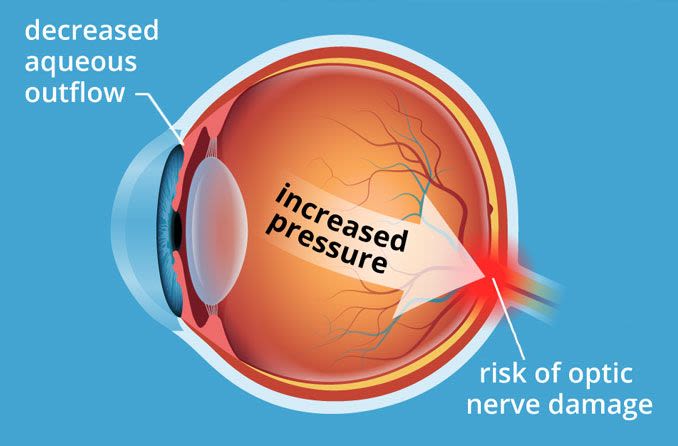Ocular hypertension: 5 Causes of high eye pressure

Schedule an exam
Find Eye DoctorWhat is ocular hypertension?
Ocular hypertension means the pressure in your eyes is higher than normal. Left untreated, high eye pressure can cause glaucoma and permanent vision loss. The medical term for the pressure inside the eye is intraocular pressure, or IOP.
An estimated three to six million people in the United States are at increased risk of getting glaucoma because of elevated IOP, or ocular hypertension.
Detecting ocular hypertension
Ocular hypertension has no obvious signs such as eye pain or red eyes. The only way to tell if you have high eye pressure is to have a comprehensive eye exam by an optometrist or ophthalmologist.
During a comprehensive eye exam, your eye doctor will measure your IOP with an instrument called a tonometer. You might also have your eye pressure checked with an air puff test. Both these IOP measurements are quick and painless.
Intraocular pressure is measured in millimeters of mercury (mm Hg). Normal intraocular pressure is 12 to 22 mm Hg. An IOP reading higher than 22 mm Hg is considered ocular hypertension.
High eye pressure significantly increases your risk of damage to the optic nerve, causing glaucoma and permanent vision loss.
If you have ocular hypertension, your eye doctor may recommend a visual field test to check for glaucoma-related vision loss.
READ NEXT: Hypotony: Low eye pressure
What causes high eye pressure?
Factors that cause or are associated with ocular hypertension are virtually the same as the causes of glaucoma. These include:
Excessive aqueous production. The aqueous (or aqueous humor) is a clear fluid that is produced in the eye by the ciliary body, a structure located behind the iris. The aqueous flows through the pupil and fills the anterior chamber of the eye, which is the space between the iris and the cornea.
If the aqueous forms faster in the eye than it can drain out, the pressure inside the eye increases, causing ocular hypertension.
Inadequate aqueous drainage. High eye pressure also can occur If the aqueous is produced at a normal rate, but drains too slowly from the eye.
Certain medications can have the side effect of causing ocular hypertension. Steroid medicines used to treat asthma and other conditions have been shown to increase the risk for high eye pressure. Be sure to tell your eye doctor if you are using steroid eye drops for any reason.
Eye trauma. An injury to the eye is another thing that can affect the balance of aqueous production and drainage, possibly leading to ocular hypertension. Sometimes this can occur months or years after the injury. During your routine eye exams, be sure to mention to your doctor if you have experienced any recent or past eye injuries.
Other eye conditions. Ocular hypertension has been associated with a number of other eye conditions, including pseudoexfoliation syndrome, pigment dispersion syndrome and corneal arcus. If you have any of these conditions, your eye doctor may recommend that you have more frequent eye exams and eye pressure measurements.
Also, race, age and family history play a role in your risk for ocular hypertension and glaucoma. Though anyone can develop high eye pressure, the following groups are generally at greater risk:
African Americans
People over age 40
Anyone with a family history of ocular hypertension or glaucoma
READ MORE: Idiopathic intracranial hypertension (IIH)
Ocular hypertension treatment
If you have ocular hypertension, your eye doctor may prescribe eye drops to reduce your eye pressure.
Because these medications can have side effects, some eye doctors choose to monitor your IOP and take action only if you show other signs of developing glaucoma.
In some cases (or if eye drops are ineffective in reducing your IOP), your eye doctor might recommend other glaucoma treatment measures, including glaucoma surgery, to treat high eye pressure.
Because ocular hypertension increases your risk of glaucoma, be sure to follow your eye doctor’s advice. Have your IOP checked at recommended intervals to monitor the condition.
READ MORE: What is hypertensive retinopathy?
Ocular hypertension. Cleveland Clinic. December 2022.
High eye pressure and glaucoma. Glaucoma Research Foundation. August 2022.
What is ocular hypertension? American Academy of Ophthalmology. May 2023.
Causes of high eye pressure (ocular hypertension) and treatment options. MyVision.org. July 2022.
Page published on Monday, March 4, 2019






